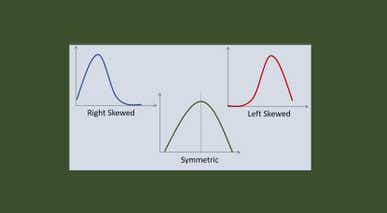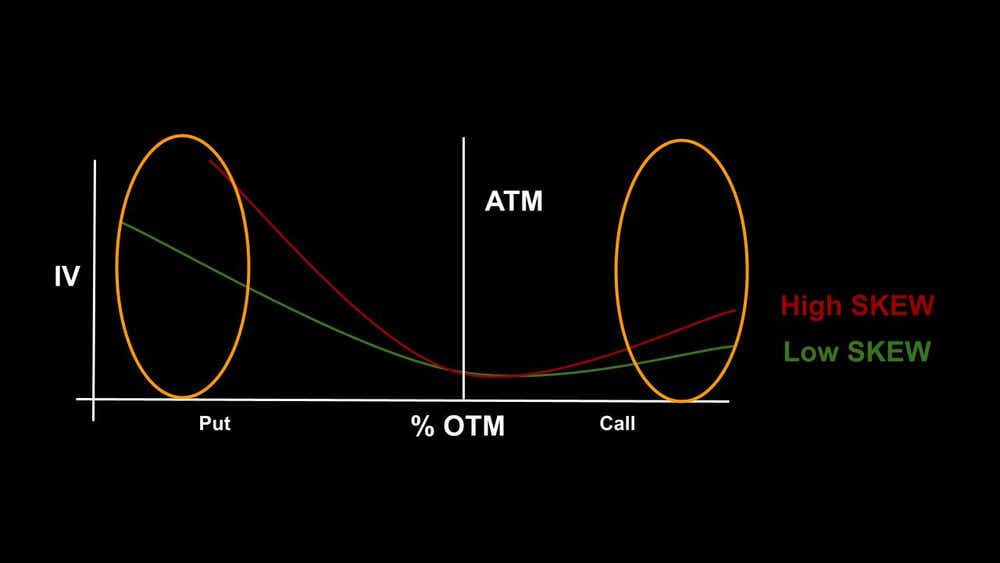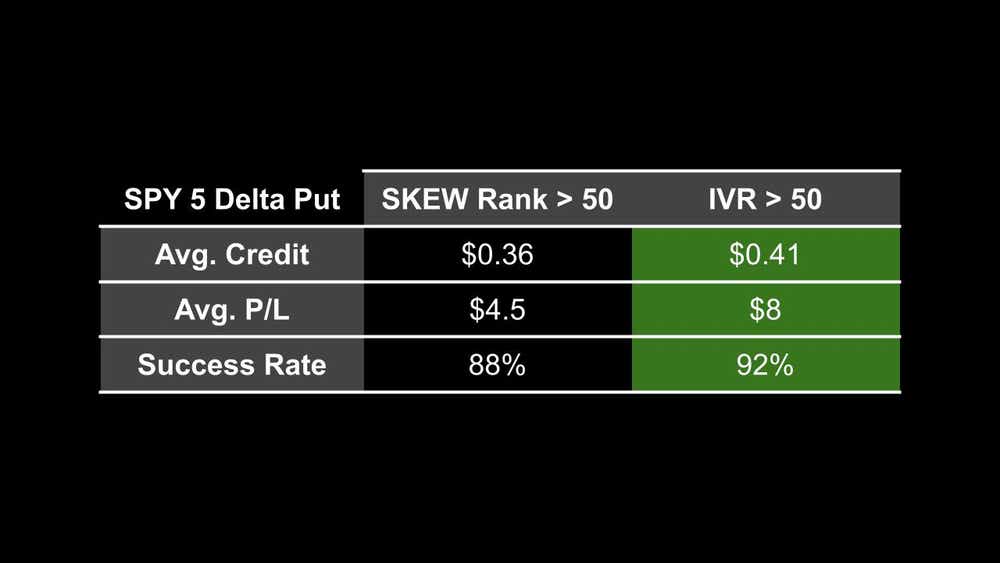Can SKEW Rank Compete with IVR? The Answer Might Surprise You

Can SKEW Rank Compete with IVR? The Answer Might Surprise You
By:Kai Zeng
The SKEW index measures the impact of distribution asymmetry as a proxy of tail risk, while the VIX assesses the impact of overall volatility risk
The SKEW index, akin to the VIX index, serves as a tool for investors to gauge market volatility and investor sentiment. A crucial distinction between the VIX (the Chicago Board Options Exchange's CBOE volatility index) and SKEW index lies in their measurements. The SKEW index measures the impact of distribution asymmetry as a proxy of tail risk, while the VIX assesses the impact of overall volatility risk. Unlike the VIX, the SKEW index focuses on large market movements by examining farther out-of-the-money (OTM) options.

The SKEW value typically fluctuates between 100 and 150, with an average of 126 over the past decade. A higher SKEW value implies a higher perceived tail risk.
.jpg?format=pjpg&auto=webp&quality=50&width=1000&disable=upscale)
This concept leads us to the idea of establishing a SKEW rank, comparable to the implied volatility (IV) rank, which could serve as a potential trading signal. The SKEW rank is defined in a similar manner to the IV rank. Here is the formula:
.jpg?format=pjpg&auto=webp&quality=50&width=1000&disable=upscale)
So here comes the question— could this be a superior trading signal than the familiar IV rank?
To answer this, a study was conducted evaluating 45 days-to-expiration (DTE) OTM puts of the SPDR S&P 500 ETF (SPY). Two scenarios were assessed: 2 delta (2 standard deviations) and 2.5 delta (2.5 standard deviations) puts. Small deltas were chosen for this analysis because the SKEW index focuses on tail risks, which have a very low probability of occurrence. The performance was compared when the IV rank was greater than 50 and the SKEW rank was greater than 50, with management at 21 DTE.
The study revealed that the 5 delta puts performed better with the IV rank than with the SKEW rank. By using the classic IV rank, traders can collect more credit and achieve a better average P/L with a significantly higher success rate.

With an even smaller delta at 2.5, the puts attracted slightly more credit when entered at a high SKEW rank, but they did not outperform those entered at a high IV rank.
.jpg?format=pjpg&auto=webp&quality=50&width=1000&disable=upscale)
The results suggest that the IV rank is a more reliable indicator for option premium sellers. It provides consistent performance and is applicable to any OTM option. Furthermore, the IV rank is simple to use and readily available on almost all options trading platforms.
In conclusion, while the SKEW index is a unique tool for measuring tail risk using deeply OTM options, it may not be the most effective indicator for premium sellers. Conversely, the IV rank, with its consistent performance and applicability to all deltas, proves to be a more valuable tool for options traders.
Kai Zeng, director of the research team and head of Chinese content at tastylive, has 20 years of experience in markets and derivatives trading. He cohosts several live shows, including From Theory to Practice and Building Blocks. @kai_zeng1
For live daily programming, market news and commentary, visit tastylive or the YouTube channels tastylive (for options traders), and tastyliveTrending for stocks, futures, forex & macro.
Trade with a better broker, open a tastytrade account today. tastylive, Inc. and tastytrade, Inc. are separate but affiliated companies.
Options involve risk and are not suitable for all investors. Please read Characteristics and Risks of Standardized Options before deciding to invest in options.
tastylive content is created, produced, and provided solely by tastylive, Inc. (“tastylive”) and is for informational and educational purposes only. It is not, nor is it intended to be, trading or investment advice or a recommendation that any security, futures contract, digital asset, other product, transaction, or investment strategy is suitable for any person. Trading securities, futures products, and digital assets involve risk and may result in a loss greater than the original amount invested. tastylive, through its content, financial programming or otherwise, does not provide investment or financial advice or make investment recommendations. Investment information provided may not be appropriate for all investors and is provided without respect to individual investor financial sophistication, financial situation, investing time horizon or risk tolerance. tastylive is not in the business of transacting securities trades, nor does it direct client commodity accounts or give commodity trading advice tailored to any particular client’s situation or investment objectives. Supporting documentation for any claims (including claims made on behalf of options programs), comparisons, statistics, or other technical data, if applicable, will be supplied upon request. tastylive is not a licensed financial adviser, registered investment adviser, or a registered broker-dealer. Options, futures, and futures options are not suitable for all investors. Prior to trading securities, options, futures, or futures options, please read the applicable risk disclosures, including, but not limited to, the Characteristics and Risks of Standardized Options Disclosure and the Futures and Exchange-Traded Options Risk Disclosure found on tastytrade.com/disclosures.
tastytrade, Inc. ("tastytrade”) is a registered broker-dealer and member of FINRA, NFA, and SIPC. tastytrade was previously known as tastyworks, Inc. (“tastyworks”). tastytrade offers self-directed brokerage accounts to its customers. tastytrade does not give financial or trading advice, nor does it make investment recommendations. You alone are responsible for making your investment and trading decisions and for evaluating the merits and risks associated with the use of tastytrade’s systems, services or products. tastytrade is a wholly-owned subsidiary of tastylive, Inc.
tastytrade has entered into a Marketing Agreement with tastylive (“Marketing Agent”) whereby tastytrade pays compensation to Marketing Agent to recommend tastytrade’s brokerage services. The existence of this Marketing Agreement should not be deemed as an endorsement or recommendation of Marketing Agent by tastytrade. tastytrade and Marketing Agent are separate entities with their own products and services. tastylive is the parent company of tastytrade.
tastyfx, LLC (“tastyfx”) is a Commodity Futures Trading Commission (“CFTC”) registered Retail Foreign Exchange Dealer (RFED) and Introducing Broker (IB) and Forex Dealer Member (FDM) of the National Futures Association (“NFA”) (NFA ID 0509630). Leveraged trading in foreign currency or off-exchange products on margin carries significant risk and may not be suitable for all investors. We advise you to carefully consider whether trading is appropriate for you based on your personal circumstances as you may lose more than you invest.
tastycrypto is provided solely by tasty Software Solutions, LLC. tasty Software Solutions, LLC is a separate but affiliate company of tastylive, Inc. Neither tastylive nor any of its affiliates are responsible for the products or services provided by tasty Software Solutions, LLC. Cryptocurrency trading is not suitable for all investors due to the number of risks involved. The value of any cryptocurrency, including digital assets pegged to fiat currency, commodities, or any other asset, may go to zero.
© copyright 2013 - 2025 tastylive, Inc. All Rights Reserved. Applicable portions of the Terms of Use on tastylive.com apply. Reproduction, adaptation, distribution, public display, exhibition for profit, or storage in any electronic storage media in whole or in part is prohibited under penalty of law, provided that you may download tastylive’s podcasts as necessary to view for personal use. tastylive was previously known as tastytrade, Inc. tastylive is a trademark/servicemark owned by tastylive, Inc.